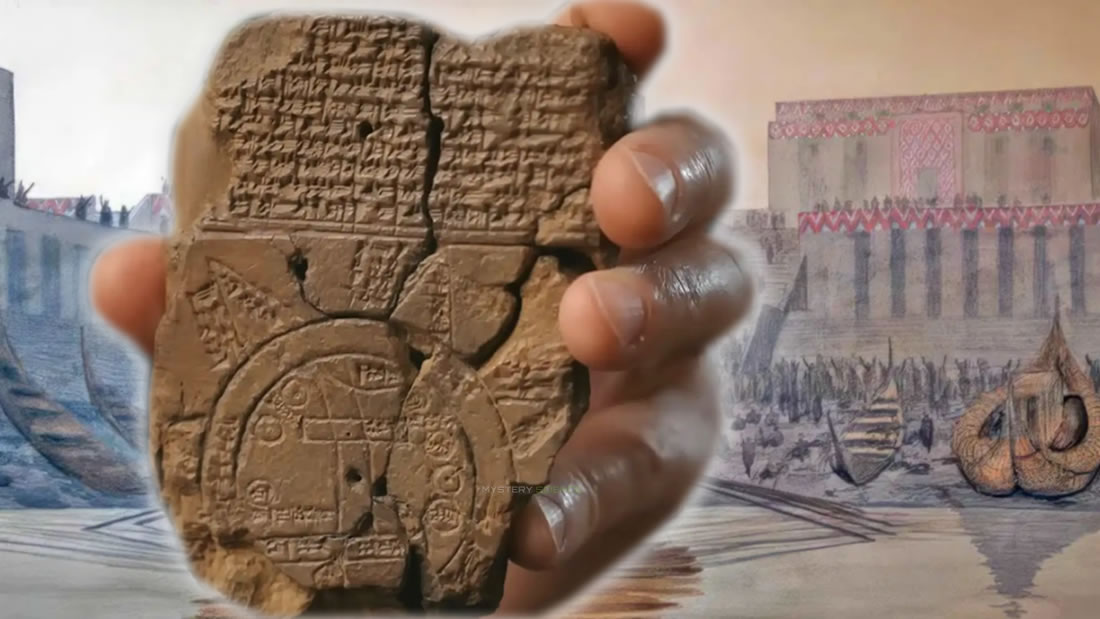An ancient tablet known as the Imago mundi is believed to be the oldest surviving map of the world. The tablet is said to describe – according to the ancient Babylonians – the first creation of the worldalmost 3,000 years ago. Recently, an English historian managed to decipher its enigmatic inscriptions.
The Babylonian tablet was created between 2,600 and 2,900 years ago. The Imago Mundi tablet has provided researchers with unique insight as it shows the beliefs and practices of ancient civilization.
The Babylonian map consists of a circular map. Along with this, there are some fragments of text written on a ancient writing system called cuneiformwhich used wedge-shaped symbols.
Reading the relic confirms the ancient Babylonians’ belief in the god of creation, Marduk, and in mythical creatures and monsters such as the Scorpion Man and Anzu, the lion-headed bird.
Its creation took place at a time when the Babylonian Empire was becoming a world leader in mathematics, architecture, culture and other scientific fields. Representatives of this civilization created an improved digital system millennia ago and They formulated a functional theory of the planets, use geometry to observe Jupiter.
Discovery of the oldest map in the world
He Imago Mundi was discovered in 1882 by the famous archaeologist Ormuzd Rassam in Sippar, an ancient Babylonian city (present-day Iraq). However, the tablet remained hidden in an excavation box for almost 150 years.
It was rediscovered in Iraq 29 years ago and is currently housed in the British Museum in London. It measures 12.2 centimeters high by 8.2 centimeters wide. This is part of the Permanent collection of the British Museum.
 The Imago Mundi, also called the Babylonian Map of the World, was discovered in 1882 by the famous archaeologist Hormuzd Rassam in Sippar, an ancient Babylonian city located in what is now Iraq. Credit: British Museum.
The Imago Mundi, also called the Babylonian Map of the World, was discovered in 1882 by the famous archaeologist Hormuzd Rassam in Sippar, an ancient Babylonian city located in what is now Iraq. Credit: British Museum.
What does Imago Mundi contain?
The tablet contains a Mesopotamian world mapwith Babylon at the center. It contains carefully engraved images and cuneiform writing.
On the tablet, Babylon is surrounded by two concentric circles which represent the ocean, called “bitter water” or “salt sea”. It is labeled with Babylon, Assyria and Elam. Eight triangular areas called “Regions” or “Islands” surround the salt sea and are labeled with distances, descriptions of the regions, and profiles of the great heroes and mythical beasts who lived in each region.
Since the acquisition of the tablet, the experts of British Museumled by Dr. Irving Finkelmresearcher at the British Museum, were able to obtain information on the beliefs of Neo-Babylonian Empire about mystical creatures and their regional domination.
 Dr. Irving Finkelm holding the nearly 3,000 year old Babylonian tablet. Credit: British Museum.
Dr. Irving Finkelm holding the nearly 3,000 year old Babylonian tablet. Credit: British Museum.
According to a video Published by Dr. Finkelm, the map depicted Mesopotamia, or the land “between the rivers,” a historical area of the Middle East that was defined at the time as the entire “known world.”
The known world and beyond…
It shows the Amer and Euphrates rivers crossing ancient Mesopotamia from north to south. Several regions are marked in cuneiform script, including Assyria, Der and Urartuwhich offers a complete vision of the known world at that time.
On the other hand, in one of the diagonals we found the expression “The Great Wall”, which describes a height of 840 cubits (about 384 meters), and also reports that its trees measure up to 120 cubits ( approximately 54 meters).
On the other hand, the triangular shapes at the edge of the map represent mountains where “the Sun cannot be seen”, indicating areas beyond the known world.
 Researchers have succeeded in deciphering the Imago Mundi. Credit: British Museum/Wikimedia Commons.
Researchers have succeeded in deciphering the Imago Mundi. Credit: British Museum/Wikimedia Commons.
Gods and mythical creatures
Tablet also refers to Babylonian god of creation, Marduk, which was associated with justice, compassion, healing and magic.
Dr. Finkel noted that although some of the text is fragmented, it mentions “ruined cities…which Marduk observes.”
According to the cuneiform writing of the Imago Mundi, the Babylonians believed in mythical creatures who lived in various regions, including a winged horse, a sea serpent, a scorpion-man and a bull-man.
“It gave us tremendous insight into many aspects of Mesopotamian thought,” Dr. Finkel said.
The importance of the tablet lies in the fact that it allows one to understand beliefs, visions, cosmology and religious practices of ancient Babylon.
Finkel also emphasized the exciting nature of such discoveries, saying: “It is also a triumphant demonstration of what happens when you have a very small, completely useless, completely useless fragment of boring writing that no one can’t understand and you attach it to something in the much larger collection and a new adventure begins again.
A publication of Mysterious science. All rights reserved. – Redistribution and redistribution of this content without prior consent is expressly prohibited. Website protected by Safe Creative.
Thank you for reading us. We invite you to follow us on our Facebookto be up to date with all the news we publish daily. You can also join our community on Telegram. We are waiting for you!
